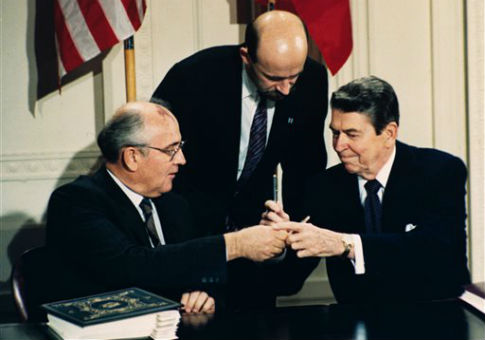Robert Service knows his subject. Assessing the Soviet Union’s demise in The End of the Cold War: 1985-1991, he starts by outlining Ronald Reagan’s fundamental change in U.S. policy. "[T]he assumption since the end of the Second World War," he writes, "had been that the West should only try to contain the USSR; no US President had ever truly endeavored to reverse the expansion of Soviet influence around the world. Ronald Wilson Reagan was determined to change things." Reagan’s desire to advance human freedom under peace is the key theme of this extraordinary book. We learn why Reagan was so passionate in this endeavor: with reference to studies that projected an existential threat to human life post-nuclear conflict, we see how Reagan saw ending the Cold War as a moral cause as much as a strategic one. But it wasn’t an easy path. Nor were Reagan’s challengers solely located abroad: many in Reagan’s cabinet and close allies such as Margaret Thatcher were skeptical of his approach to diplomacy. They feared that Reagan was being manipulated by Soviet leaders under the pretense of reform. Simultaneously, we see how Soviet leaders were equally paranoid that the United States was planning a pre-emptive nuclear strike against them. In the early 1980s, trust was in short supply.
Service pays balanced attention to both the U.S. and Soviet administrations. Stepping inside the Kremlin’s halls, we learn how Gorbachev rose to power with a reputation for energetic reforms. The need for reform had become urgent due to decades of Soviet economic mismanagement and poor leadership. Prior to Gorbachev, the Soviet Union was crumbling under the physically frail and ideologically inflexible leadership of Andropov and Chernenko. Unwilling to confront the fundamental structural failings of their system, they had instead retrenched that system—and its citizens—further behind the Iron Curtain. The Soviet leadership also lacked sufficient resources to support their interests in critical frontier states such as Poland.
But then came the break. With Gorbachev at the table, Reagan decided to roll the dice. Pushing often hesitant Western European nations—especially France—and bucking against a European press supplicant to Soviet propaganda, Reagan built support for his strategy of negotiation alongside military strength. We learn that many of Reagan’s political and diplomatic triumphs were rooted in his own deeply original thinking. In seeking to undercut Soviet authoritarianism, for example, he hired a Hollywood director, Charles Wick, to head the U.S. Information Agency. With a boosted budget, the agency funded pro-American media efforts across Europe and Russia. Far from the handsome wisecracking cowboy buffoon of much popular history, Reagan, was a keen and able strategist. Service notes that as negotiations proceeded and Gorbachev’s government began to make concessions, Regan "sensibly avoided humbling them in private. It was better to prevent the flow of concessions by the Soviet side from stagnating." While Service identifies Reagan as the diplomatic linchpin that ended the Cold War, he also pays close attention to Gorbachev’s unique personality. In Gorbachev we see a leader faced with the threat of total social collapse genuinely committed to radical economic and political reforms. We also learn how Gorbachev consolidated his leadership by surrounding himself with supporters.
The End of the Cold War is, necessarily, a long book—a long masterpiece. By the book’s conclusion, we have come to understand how two good men in the right positions at the right time forged a remarkable history. As Service puts it, "the impossible had turned into the probable and finally into the real."
